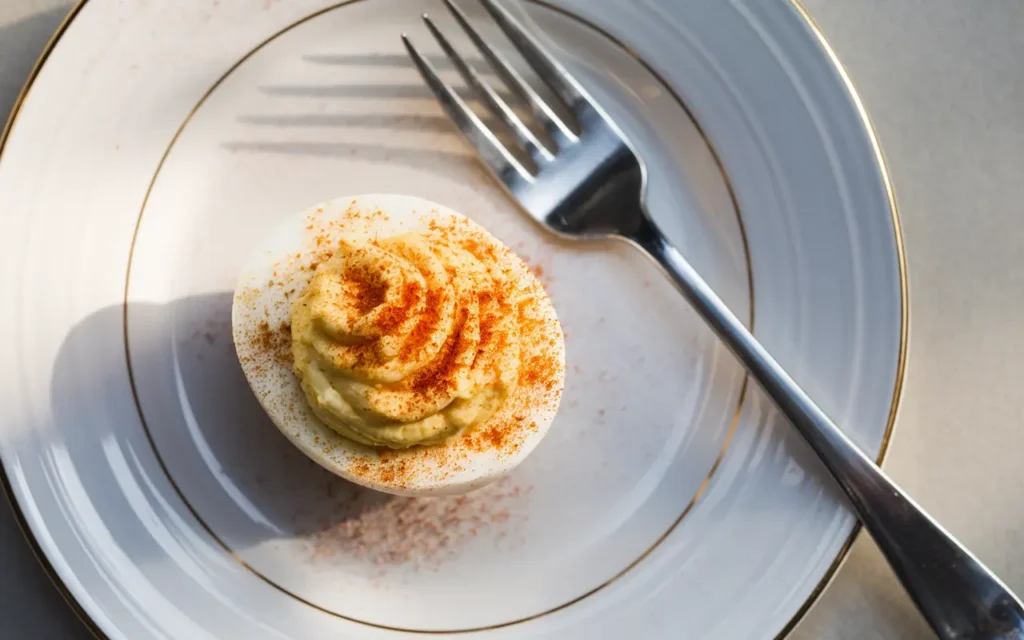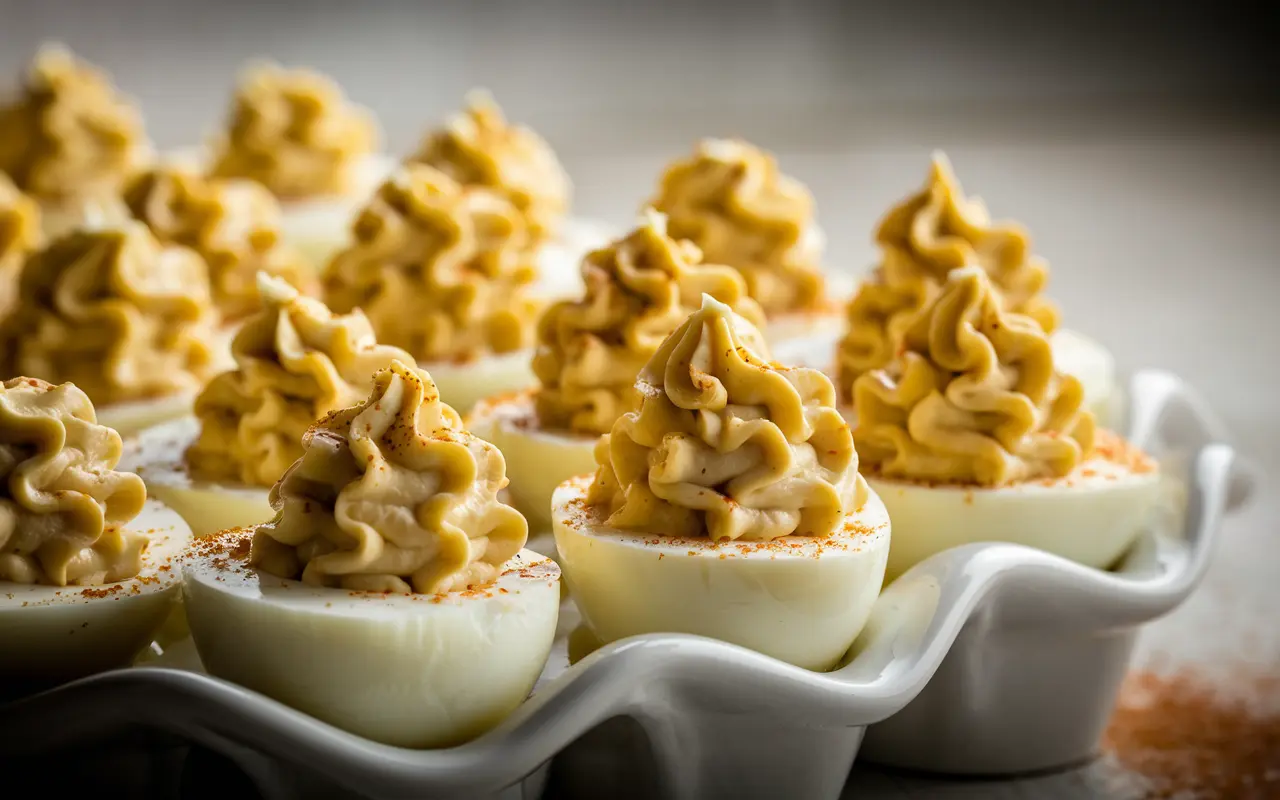Deviled Eggs, done the classic way without guesswork. Easy peel, smooth mix, tidy piping that looks pro. Your platter will be the party favorite.
Table of Contents
There’s a reason Deviled Eggs never leave the party early. Creamy yolks, a little tang, and that signature paprika make them a crowd-pleasing bite every time. These Classic Deviled Eggs bring back the feeling of family tables, shared dishes, and easy comfort, just like Grandma’s Fried Chicken, golden and crispy, passed around on Sunday afternoons.
Simple ingredients, quick steps, dependable results. If you’ve been looking for a no-guesswork guide to Deviled Eggs that hold their shape and taste amazing, you’re in the right place. Let’s make a platter that disappears fast.
The Untold Story Behind Classic Deviled Eggs, Podcast
Join Mia and Chef Brooke as they uncover the surprising history of deviled eggs, why they became a staple in American gatherings, and simple chef secrets to elevate the flavor. If you love kitchen stories, smart tips, and cultural roots behind iconic dishes, this podcast episode is for you.
Where Deviled Eggs Came From, Why They Still Work
From early stuffed eggs on family tables to mid-century platters at church socials, Deviled Eggs earned their place because they are creamy, tangy, and easy to share, much like a comforting Chicken Pot Pie. Generations kept small tweaks that felt like home. A little more mustard for brightness. A whisper of paprika for color and aroma. The result stayed familiar and welcoming.
What to Keep From Tradition
Cook the eggs gently for sunny yolks. Mash while warm for the smoothest texture. Balance richness with a touch of acidity. Pipe neatly or spoon simply, then finish with a light dusting of paprika. Follow these small habits and your Classic Deviled Eggs will taste like memory, yet feel right in a modern kitchen.
Nutrition Facts
One half of a Deviled Egg gives a quick, satisfying bite without a big calorie load. Values below are estimates for Classic Deviled Eggs made with mayonnaise and yellow mustard.
| Serving Size | Calories | Protein | Fat | Carbs | Fiber | Sodium |
|---|---|---|---|---|---|---|
| 1 half-egg | 60 | 3g | 5g | 1g | 0g | 95mg |
Prep & Cook Time
- Prep Time: 10 minutes
- Cook Time: 12 minutes
- Cooling Time: 10 minutes
- Total Time: 32 minutes
Ingredients, With Purpose
A short, well-chosen list makes the best Deviled Eggs. Keep the pantry simple so your Classic Deviled Eggs taste bright and creamy without guesswork.
Ingredient List
- 6 large eggs
- 3 tablespoons mayonnaise
- 1 teaspoon yellow mustard
- 1 teaspoon white vinegar
- Salt, to taste
- Black pepper, to taste
- Paprika, for garnish
- Optional add-ins: a pinch of sugar, chopped pickles, or a touch of hot sauce
🍳 Grandma’s touch: She sometimes added a small spoonful of sweet relish for a tangy-sweet surprise.
Why Each Ingredient Matters
Eggs form the base of Deviled Eggs, and slightly older eggs peel more cleanly. If you’re curious about why eggs are such a powerhouse in your kitchen, take a look at the health benefits of eggs, they’re more than just a binding ingredient.
Mayonnaise adds body and a smooth mouthfeel for Classic Deviled Eggs that taste rich but not heavy. Yellow mustard brings gentle heat and color, while Dijon sharpens the profile if desired. White vinegar brightens the filling so Deviled Eggs never taste flat. Salt and pepper wake up the mix, and paprika gives the familiar aroma and color that signal a true classic.
Optional Add-Ins
To personalize your Classic Deviled Eggs, fold in a teaspoon of sweet relish for tangy sweetness, a few drops of hot sauce or a pinch of cayenne for warmth, or finely chopped dill pickle with chives for freshness. These small tweaks keep the spirit of Deviled Eggs without overpowering the base.
Preparation, Step by Step
Follow this method to keep yolks sunny, the filling silky, and plating tidy so your Deviled Eggs look as good as they taste. The steps scale cleanly for big trays of Classic Deviled Eggs.
Boil Without Overcooking
Place the eggs in a saucepan and cover with cold water by about an inch. Bring to a full boil over medium high heat, turn off the heat, cover, and let the eggs sit for 12 minutes. This gentle finish prevents the gray ring and sets the yolks for smooth Deviled Eggs.
Cool and Peel Cleanly
Move the eggs to an ice bath for about 10 minutes. Tap the shells all over, peel under a thin stream of running water, and pat dry. The shock helps the membrane release so the whites stay smooth for neat Classic Deviled Eggs.
Make the Filling Smooth
Slice the eggs lengthwise and nudge the yolks into a bowl. Mash while still slightly warm, then mix in the mayonnaise, mustard, vinegar, a pinch of salt, and black pepper until silky. Taste and adjust so the Deviled Eggs filling is balanced, adding a touch more vinegar or mustard if it feels dull.
Fill and Garnish
Spoon or pipe the filling back into the whites so it mounds slightly. Dust lightly with paprika, then chill 20 to 30 minutes. The short rest firms edges, deepens flavor, and makes Classic Deviled Eggs easier to transport and serve.

Yield and Timing
This recipe makes 12 halves. Plan for about 10 minutes of active prep, 12 minutes of cooking, and roughly 10 minutes of cooling, for a total near 32 minutes. Double or triple the batch for a party platter of Deviled Eggs without changing the ratios.
Pro Tips From the Test Kitchen
Small habits make Deviled Eggs look polished and taste balanced. Start with eggs that are at least a few days old so shells release more easily. For Classic Deviled Eggs with a silky filling, mash yolks while they are still slightly warm so they break down smoothly before you add mayonnaise, mustard, and vinegar. If you want the most even texture, press the yolks through a fine mesh sieve, then whisk in the seasonings. Keep the filling on the thicker side so it pipes cleanly and holds its shape on the platter.
Seasoning and Balance
Taste the filling before you pipe. Deviled Eggs shine when richness, salt, and acidity line up. If the mix feels heavy, add a few drops of vinegar or a touch more mustard. If it tastes sharp, lift it with a pinch of sugar or a little extra mayonnaise. Classic paprika on top adds aroma and color without overwhelming the profile of Classic Deviled Eggs.
Clean Presentation
For neat Deviled Eggs, use a small piping bag or a zip bag with the corner snipped. Wipe the tip between eggs to keep ridges defined. Chill the filled halves for 20 to 30 minutes so edges set. Garnish right before serving so paprika stays vivid and chives stay fresh.
Make-Ahead, Storage, and Food Safety
You can prep Deviled Eggs in stages. Boil eggs up to one week ahead if you keep them unpeeled and refrigerated. For Classic Deviled Eggs made the day before, store whites and filling separately. Cover the whites and keep them cold. Hold the filling in a sealed bag, press out the air, and refrigerate. Pipe and garnish within a few hours of serving for the best texture.
Safe Serving Windows
Keep Deviled Eggs at or below 40°F, 4°C, until service. At room temperature, limit serving time to about 2 hours, or 1 hour if the environment is hotter than 90°F, 32°C. Safe handling is key here. Filled halves keep well for up to 2 days in the refrigerator when covered. Discard leftovers that have sat out too long rather than risking food safety. Cold packs and a tight container make transport easier and safer for party trays.
Troubleshooting Guide
Even simple Deviled Eggs can throw a curve, and quick fixes save the batch. If the filling is too loose, whisk in extra mashed yolk if you reserved a half, or fold in a small spoon of potato flakes as a last resort. If it is too stiff, loosen the mix with a teaspoon of mayonnaise or a few drops of vinegar until it turns creamy again.
Peeling Problems
If shells stick and whites tear, switch to an ice bath right after cooking and let the eggs rest for a full 10 minutes. Peel under a thin stream of water to help lift the membrane. For future batches of Classic Deviled Eggs, use eggs that are a few days old and avoid super fresh ones.
Grainy Yolks or Dull Flavor
Grainy texture means the yolks didn’t break down fully. Try pressing them through a sieve for a smoother mix. Eggs also bring important nutrients, as explained in the Harvard School of Public Health’s overview. If the flavor feels dull, adjust with salt, vinegar, or mustard until it tastes bright and balanced.
Serving Ideas and Pairings
Fresh Sides That Lift Deviled Eggs
Deviled Eggs shine when the rest of the spread adds crunch, freshness, and contrast. Pair them with crisp vegetable sticks, lightly salted crackers, and a bright lemon-dressed spinach salad (and if you’re wondering why spinach is always a good choice, read about the health benefits of spinach) so the creamy filling stays front and center.
Hearty Dishes for a Fuller Table
Set Classic Deviled Eggs next to roasted chicken, a simple pot roast, or Grandma’s Mashed Potatoes for a comforting, crowd-pleasing spread. On party platters, add olives, pickles, and celery sticks for snap and acidity that balance the richness.
Simple Garnishes and a Savory Boost
Keep garnish minimal with chives, dill, or a light sprinkle of smoked paprika. For a savory boost, use finely crumbled cooked beef bits instead of bacon so you keep depth of flavor without overshadowing the eggs.
How to Plate for Impact
Arrange Deviled Eggs in tight concentric circles so the platter looks full. Wipe edges clean and chill for 20 to 30 minutes so the filling sets. Right before serving, add a light dusting of paprika and a few herb sprigs. The color contrast helps Classic Deviled Eggs read as fresh and appetizing in photos and on the table.
Top 4 FAQs
How far in advance can I make Deviled Eggs
You can hard-boil and peel eggs 1–2 days ahead. Prepare the filling ahead and keep whites and filling stored separately in the fridge, then assemble just before serving.
How long can Deviled Eggs safely sit out
Deviled Eggs should not sit at room temperature more than about 2 hours (or 1 hour if above 90 °F / 32 °C). After that, refrigerate or discard to avoid food safety risks.
Why is my Deviled Eggs filling runny or weeping
If the filling is too loose, it may have too much moisture or was made too early. Keep the mixture slightly thick, and fill the whites close to serving time. Adjust mayo, mustard, and acid ratios to get the right texture.
How do I make hard-boiled eggs easier to peel
Use eggs that are a few days old instead of fresh ones. Chill boiled eggs in an ice bath immediately, then peel under running water to help release the membrane cleanly.
Chef Brooke Tip
Mash While Warm
Warm yolks blend smoother with mayo and mustard. Don’t wait until they’re cold. That’s how you get that silky filling every guest remembers.
Perfect Texture Trick
For ultra-smooth Deviled Eggs, push the yolks through a fine mesh sieve. It takes 30 seconds and makes the filling look restaurant-level.
Chill Smart
Pop the filled halves in the fridge for 20 minutes before serving. It firms the edges, deepens flavor, and keeps your Classic Deviled Eggs picture-perfect.

